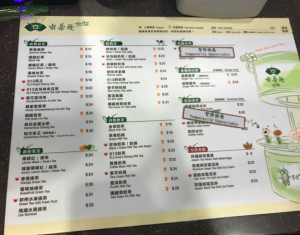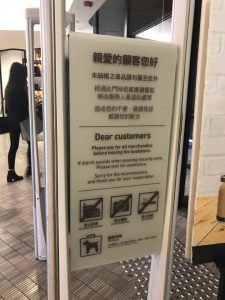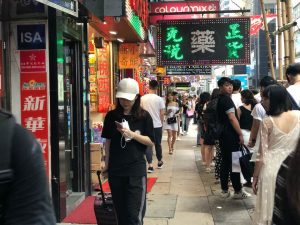Hong Kong is known as one of the global cities in Asia, where the official language includes English other than their own language. As many people would assume, I also expected that communication in most places in Hong Kong would be smooth in any situation. However, unlike my initial thoughts, Hong Kong’s culture was composed heavily towards the authentic culture of Chinese except tourist-popular places in terms of language use. Having two official languages didn’t really reflect the modernization of its culture but was rather used as a basic tool for the minimal communication among people.
During my first week in Hong Kong, most places I visited were popular places where most tourists would normally visit first. As shown in the Example 1 below, most restaurants offered English version menus and workers didn’t have much of problems communicating with foreign customers. Along with restaurants, buildings around were very modernized unlike many buildings in Chinatown in English-spoken countries. These scene mostly proved how “English was used to signify modernity or cosmopolitanism” (Leeman and Modan, 335) in Hong Kong. Almost all the buildings in the developed area of Hong Kong or any public ares had most instructions or description in two languages, English and Chinese. As shown in Example 2, both languages were depicted equally prominent.


However, once you go out of those modernized regions of Hong Kong to local areas, things were much different. Many of local shops or restaurants in places such as Sheung Wan or Wan Chai rather portrayed the first wave of redeveloping Chinatown in somewhat similar way in terms of language use. Apart from having fancy lights to emphasize the name of the shops, which is just an element of emerging technologies in the 21st century, hardly any names of small businesses were specifically focused to tourists but to the local people (Example 3). One or two shops had menus available in English, in which case, I would have to just order food by pointing at the picture I wanted.

Just looking at the written language use in Hong Kong, it clearly depicted Hong Kong as multi-lingual community. Yet the spoken language didn’t quite portrayed the community as multi-lingual country. Before coming to Hong Kong, I read in an article that the local people aren’t very favorable to those who speak Mandarin or English. As mentioned in the article, in some very authentic places around my office, workers didn’t really welcome people who spoke English to them and just would answer back in Cantonese in abrupt manner. In such cases, body language or contextual understanding were more helpful in communicating with the local people.
Although my thoughts only depict one side of what the actual language use is meant to convey, it was very interesting to me how use of English had apparent purpose as a communicating tool. Unlike how “French on the restaurant sign conveys distinction and a sense of authenticity” (Leeman and Modan, 335) as an example or “to demonstrate their cosmopolitan and sophistication” (Leeman and Modan, 354), instructions or signs in Hong Kong were mostly used to deliver messages clearly to foreigners.
[Citation]
Leeman, Jennifer, and Gabriella Modan. “Commodified Language in Chinatown: A Contextualized Approach to Linguistic Landscape.” Journal of Sociolinguistics, vol. 13, no. 3, 2009, pp. 332-362.
